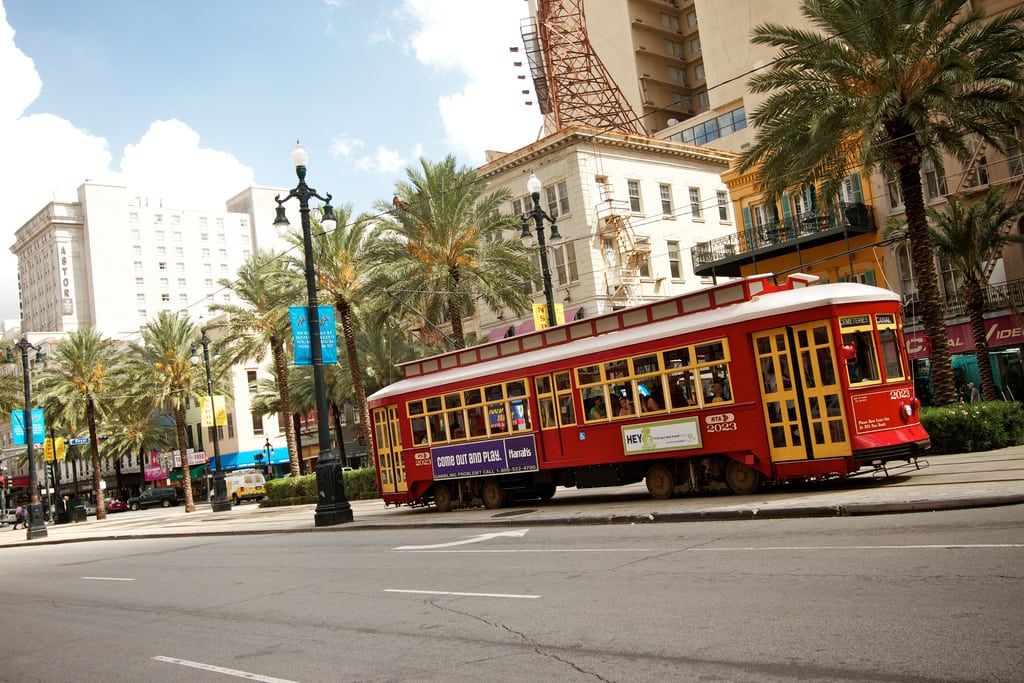Skift Take
The streetcar will mostly benefit tourist traveling downtown from the central train station, but do little to connect neighborhoods to the city center.
With the Super Bowl less than three months away, New Orleans is rushing to lay streetcar tracks through one of its busiest corridors to connect by trolley the Louisiana Superdome and the French Quarter.
The Big Easy — which will be the site of the big game Feb. 3 — is no stranger to Super Bowls. In the 47 years of game’s history, this will be the 10th time for New Orleans to play host.
But this will be the city’s first Super Bowl since Hurricane Katrina struck in August 2005, killing hundreds and leaving 80 percent of the city under water.
The snarled traffic, construction crews and flying dust along Loyola Avenue where the new streetcar line is being laid embodies the frantic pace of preparations for the Super Bowl. Streets are being repaved in the French Quarter, the airport is undergoing a major renovation and crews are fixing sidewalks, lights and potholes.
For many locals, the streetcar is seen as more than a show of Super Bowl pizzazz.
“For anybody who’s trying to cut down on gas, walk out their front door, go a few blocks and catch the transit system, it’ll be good,” said Robert Miles, a 47-year-old chef at one of the big hotels on Loyola. “It was not a waste of money.”
The line will run down Loyola from the Union Passenger Terminal, where Amtrak trains and intercity buses are based, to Canal Street.
On Canal Street, travelers will be able to hop onto other streetcars and get to the nearby French Quarter, the National World War II Museum, the Cemetery District, the oaks of Audubon Park, the mansions of St. Charles Avenue and the art museum, golf courses and lagoons of City Park.
Funding comes from a $45 million federal transportation grant. The U.S. Department of Transportation is funding similar lines in other cities to connect long-distance railway travelers to streetcars.
The target is a traveler like Lawrence Freeman, a 50-year-old photographer from Seattle. He had recently arrived at the Union Passenger Terminal by train from Washington, getting in late one evening. He walked from the train station to his hotel.
“I’m a walker, it was no big deal, except that I don’t know what this area is, I don’t know where I’m going,” he said about his walk into downtown. “I just headed for the tall buildings.”
If there had been a streetcar, he said he would have taken it. Travelers will be able to do just that by mid-January, when the Loyola line is completed.
But the project also is viewed as a downtown revitalization tool.
“Until the streetcar was announced, there was little activity, or anticipation of development along Loyola,” said James Amdal, senior fellow at the Transportation Institute at the University of New Orleans. “That has definitely changed.”
The changes along Loyola are palpable. High-rises that had been empty for years — vacant well before Katrina hit — are being renovated. An upscale supermarket opened nearby and a $75 million residential and retail project called the South Market District is set to start soon.
“Streetcars have proven to be an incredible source for revitalizing commercial corridors,” said Rachel Heiligman, executive director of the advocacy group Transport for NOLA.
Still, it hasn’t all gone smoothly.
The work is running over budget and is behind schedule. The New Orleans Regional Transit Authority pegs the cost at $52 million, about $7 million more than projected.
“When you open up a street in a city this old you find things that you don’t expect,” said RTA spokeswoman Patrice Bell Mercadel. “This has become more than a streetcar project.”
Power company Entergy New Orleans and the city’s sewerage department have been brought in and utilities have had to be relocated. Workers found a petrified cypress log and an old underground ice house no one knew existed, she said. The work also has run into an old arched brick sewer main.
Also, some streetcar advocates say putting a line down Loyola was a silly proposition in the first place.
“I told them they should have gone down Rampart Street where there had already been a streetcar line,” said Jack Stewart, a local streetcar historian.
He also was unhappy with the decision to place the streetcar tracks on Loyola’s roadway instead of on the median like other streetcars in the city. Even the city’s new master plan calls for streetcars to run on their own lanes separate from vehicular traffic.
“It’s a grand mess,” Stewart said. “It’s a streetcar from nowhere to nowhere that will get mired in traffic. During the football game it will not be able to operate because there will be so many cars.”
There’s also the fear this project — designed to appeal to downtown tourists— is using up money that might have been spent on streetcar projects with greater benefits for struggling neighborhoods. For years, plans for a streetcar to run down St. Claude Avenue into the city’s older immigrant neighborhoods have been foiled.
“If the priorities are directed to the local resident and the local economy and not the tourist economy, then you strengthen your real city, and you keep it strong for tourism, versus creating a downtown that is increasingly like Disneyland,” said Roberta Brandes Gratz, a New York writer and urban critic who recently bought a house in New Orleans. “If tourism is your most important economic driver, you have a bankruptcy of ideas.”
Associated Press writer Stacey Plaisance in New Orleans contributed to this report.
![]()
The Daily Newsletter
Our daily coverage of the global travel industry. Written by editors and analysts from across Skift’s brands.
Have a confidential tip for Skift? Get in touch
Tags: new orleans, super bowl
Photo credit: A trolley rolls down Canal Street in New Orleans in July 2011. Marcin Wichary / Flickr.com
